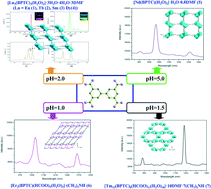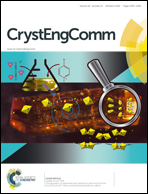Polymorphic Ln(iii) and BPTC-based porous metal–organic frameworks with visible, NIR photoluminescent and magnetic properties†
Abstract
By reaction of 3,3′,5,5′-biphenyltetracarboxylic acid (H4BPTC) with various lanthanide ions, seven novel three dimensional (3D) lanthanide metal–organic frameworks (MOFs) have been prepared under solvothermal conditions, namely, [Ln3(BPTC)3(H2O)2]·3H3O·4H2O·3DMF (DMF = N,N-dimethylformamide, Ln = Eu (1), Tb (2), Sm (3) Dy (4)), [Nd(BPTC)(H2O)2]·H3O·DMF (5), [Er2(BPTC)(HCOO)3(H2O)2]·(CH3)2NH2 (6), and [Tm12(BPTC)8(HCOO)11(H2O)10]·10DMF·7(CH3)2NH2 (7). Combining different lanthanide ions and diversity of coordination modes of the H4BPTC ligand, the seven compounds display interesting structural characteristics. Of these, compounds 1–4 are isostructural and demonstrate a unique 3D coordination framework containing two types of 1D channel, that is built by the novel trinuclear [Ln3O22] SBUs. Compound 5 can be described as a new 3D open-framework structure with quadrilateral-shaped 1D channels based on [Nd2O16] SBUs. Compound 6 has a new 3D pillar network feature constructed by trapezoidal chains linked by bridging BPTC4− ligands, whilst compound 7 exhibits a 3D network with a number of rare oval-shaped channels along the [101] direction. The H4BPTC ligand exhibits five new coordination modes, which are firstly reported in M-BPTC frameworks. Compounds 1–7 all display their typical emission bands upon irradiation at the ligand band at room temperature. Compounds 1–4 present strong characteristic emissions in the visible region, of which compounds 1 and 2 show millisecond luminescence lifetimes. The NIR photoluminescent of lanthanide MOFs is less well observed, especially for the Tm(III) compounds. Owing to the good sensitization of the H4BPTC ligand, compounds 5–7 display near-infrared region (NIR) emission with microsecond luminescence lifetimes. In addition, compounds 2, 5, 6 and 7 exhibit global antiferromagnetic behaviors, of which compound 5 shows a weak ferromagnetic coupling at 235 K.


 Please wait while we load your content...
Please wait while we load your content...